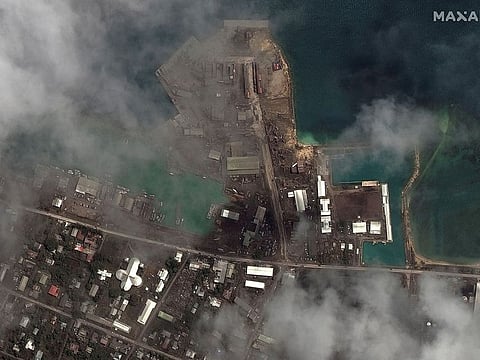All homes on one of Tonga’s islands destroyed, three dead
Some areas still cut off Airport closed, hampering international aid efforts

Sydney/Wellington: All the homes on one of Tonga’s small outer islands have been destroyed by a massive volcanic eruption and tsunami, with three people so far confirmed dead, the government said on Tuesday in its first update since the disaster struck.
With communications badly hampered by the severing of an undersea cable, information on the scale of the devastation after Saturday’s eruption had so far mostly come from reconnaissance aircraft.
But the office of Prime Minister Siaosi Sovaleni said in a statement that every home on Mango island, where around 50 people live, had been destroyed, only two houses remained on Fonoifua, and Namuka island had suffered extensive damage.
Tongas deputy head of mission in Australia, Curtis Tuihalangingie, earlier said pictures taken by the New Zealand Defence Force (NZDF) showed “alarming” scenes of a village destroyed on Mango and buildings missing on Atata island, which is closer to the volcano.
“People panic, people run and get injuries. Possibly there will be more deaths and we just pray that is not the case,” Tuihalangingie told Reuters.
Sovaleni’s office said a 65-year-old woman on Mango Island and a 49-year-old man on Nomuka Island had been killed, in addition to the British national whose body was found on Monday.
A number of injuries were also reported.
Tsunami waves reaching up to 15 metres hit the Haapia island group, where Mango is located, and the west coast of Tongas main island, Tongatapu, the prime minister’s office said. Residents were being moved to evacuation centres as 56 houses were destroyed or seriously damaged on that coast.
Atata and Mango are between about 50 and 70 km from the Hunga Tonga-Hunga Ha’apai volcano, which sent tsunami waves across the Pacific Ocean when it erupted with a blast heard 2,300 km (1,430 miles) away in New Zealand.
ASH COVER
Satellite images from Sunday show the caldera of Hunga Tonga-Hunga Haapai has collapsed and the island has lost a substantial percentage of its initial surface area, said the U.N. Office for the Coordination of Humanitarian Affairs (OCHA).
A search and rescue operation began on Sunday for Atata island, which has a population of about 100 people, with an evacuation underway.
“Challenges to sea and air transportation remain due to damage sustained by the wharves and the ash that is covering the runways,” the PM’s office said.
A thick layer of ash blankets the islands, the aerial images provided to Tonga by New Zealand and Australia showed.
As well as the damage locally, scientists say the eruption could have a long lasting impact on coral reefs, coastlines and fisheries in the wider region, as well as causing acid rain.
At least 2 km of Peru’s coast and two beaches were dirtied by oil spilled from a discharge ship rocked by waves caused by the eruption, Peruvian Environment Minister Ruben Ramirez said.
The archipelago’s main airport, Fuaamotu International Airport, was not damaged but the ash is preventing full operations, hampering international relief efforts.
The OCHA cited Tongan officials as saying that clearing the runway was being done manually, with the earliest opening being on Wednesday.
Clean water sources remain a concern and the government has advised people to drink only bottled water as sources may be contaminated with ash, debris and the sea, the OCHA said.
The Tongan navy has deployed with health teams and water, food and tents to the Ha’apai islands, with more aid sent on Tuesday, the prime minister’s office said.
The NZDF images, posted on Facebook and confirmed by Tuihalangingie, showed tarpaulins being used as shelter on Mango, one of the kingdom’s 176 islands.
Sign up for the Daily Briefing
Get the latest news and updates straight to your inbox



